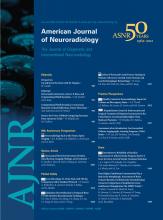We thank Drs Schramm and Klotz for their interest in our article and this important topic.1 They are indeed correct that based on our reported delay-insensitive CTP5 software package raw data, “one can reversely deduce that the average MTT of the normal brain … would have to be approximately 9 seconds … in total disagreement with basically all normal MTT values that can be found in the literature. …”
In brief, this discrepancy is explained by the fact that the CTP5 delay-insensitive postprocessing software used for our study—as noted in our “Materials and Methods” section—was a research version that required appropriate DICOM scaling of the raw data values if these were to be used for absolute quantitation of the CTP parameters; this scaling was not automatically performed by the Analyze third-party software package (Analyze 8.1; Analyze-Direct, Mayo Clinic, Rochester, Minnesota) used for our analyses. (The CTP5 beta software was intended for research use only and has since been replaced by the now commercially available CTP 4D software [http://www.gehealthcare.com/usen/ct/products/docs/CT_Clarity_062411_pg48-49.pdf], for which this scaling factor is not an issue).
For absolute quantification of the CTP5 MTT maps, the required scaling factor is 2, meaning that the correct “reversely deduced” average MTT value derived from our results is, in fact, approximately 4.5 seconds. This value is not only in agreement with the literature but is also smaller than the 4.8 seconds derived by using the delay-sensitive (CTP3) standard algorithm and is in keeping with the expected results as outlined in Drs Schramm and Klotz's letter. (Additionally, if we apply this scaling, our absolute quantitative delay-corrected MTT threshold for “true” ischemic penumbra becomes 6.75, rather than 13.5 seconds.)
Hence, the values we reported for MTT penumbral thresholds were specific to our postprocessing/analysis platforms and were not intended for use to “back-calculate” absolute quantitative MTT parameter values in clinically normal brain. Indeed, the most important conclusions of our article underscore this point—that the CTP threshold values reported in the literature are platform-specific, are not standardized, and hence are not necessarily generalizable to acquisition and postprocessing protocols other than those specifically under investigation (in our case, CTP3 and CTP5). Moreover, absolute quantification of CTP parameter values is highly variable and critically dependent on many factors, such as correct placement of a venous scaling region of interest and estimation of hematocrit. For these reasons, we favor the use of relative, rather than absolute, perfusion values for our clinical stroke work.
The aims of our study were the following: 1) to determine which CTP map or maps optimally distinguish benign oligemia from true “at-risk” penumbra, and 2) to confirm earlier reports suggesting that specific threshold values might vary according to the postprocessing platform used. Despite the considerations discussed above, we found—by using both the delay-sensitive and the delay-insensitive software—that both relative and absolute MTTs were the most accurate CTP maps for determining “critical” penumbra. This result was irrespective of the scaling factors required for absolute quantification or other potentially confounding technical differences between the commercial and beta versions of the software, which were outside the scope of our study (eg, the degree of image noise). In this regard, it was not our goal to compare the accuracy of the delay-sensitive-versus-delay-insensitive platforms. Had this been the case, we would have studied a more homogeneous highly selected patient cohort, all with significant proximal large-vessel occlusions (ICA and/or M1) so as to target the marked contrast arrival-time differences between regions with otherwise similar baseline cerebral blood flow.
We appreciate this opportunity to clarify our work, apologize for any confusion in the interpretation of our results, and again thank Drs Schramm and Klotz for helping to highlight these important issues.
Reference
- 1.↵
- © 2012 by American Journal of Neuroradiology












